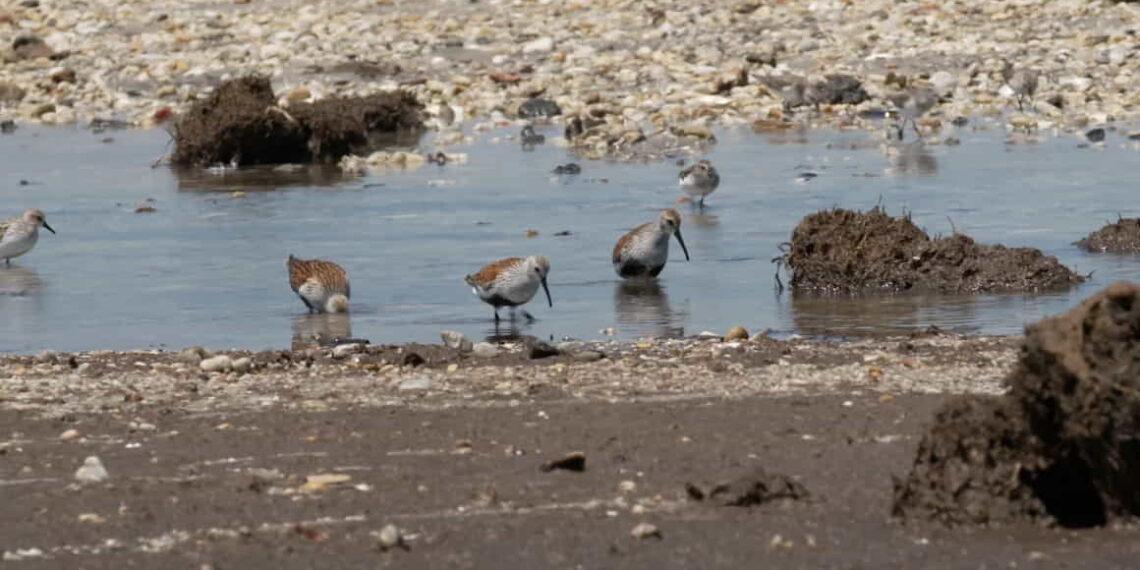Bird Poop: Key to Stopping the Next Flu Pandemic?
Could bird poop hold the secret to preventing the next flu pandemic? Researchers believe it might, and they’re looking to a unique ecosystem in Delaware Bay to find answers.
The Spring Migration: A Crucial Moment for Science
Each spring, Delaware Bay becomes a hub of activity. First, horseshoe crabs emerge from the waters, laying their eggs under the full moon in May. Soon after, hundreds of thousands of shorebirds flock to feast on these eggs, gaining essential nutrients before continuing their long migration from South America to the Arctic. This natural spectacle is not only a marvel of nature but a goldmine for scientists tracking the spread of flu viruses.
Amid growing concerns over the spread of the H5N1 avian flu virus in the U.S., this year’s research has become more urgent. The flu has already devastated poultry flocks and dairy cattle, raising fears of a larger outbreak.
Collecting Bird Poop: A Vital Task
For almost 40 years, Dr. Robert Webster, a virologist from New Zealand, and his team have been collecting bird poop (or guano) from Delaware Bay. Why? Because bird droppings are teeming with viruses, including flu strains. In fact, nearly every known influenza subtype, except for two, has been found in birds. This discovery helped Dr. Webster realize that flu viruses don’t just replicate in a bird’s respiratory system—they also multiply in their intestinal tract and are spread through their droppings, often ending up in water sources.
When Dr. Webster first visited Delaware Bay in 1985, his team found that 20% of the bird poop samples they collected contained influenza viruses. They quickly realized that the region was an ideal place to study how flu viruses travel along the Atlantic flyway, the migratory path that stretches from South America to the Arctic.
Tracking Viruses: A Long-Running Study
The project, now led by Dr. Richard Webby at St. Jude Children’s Research Hospital, has become one of the longest-running influenza studies of bird populations in the world. Webby and his team work closely with the World Health Organization to monitor the ecology of influenza in animals.
Predicting pandemics, Webby says, is similar to predicting tornadoes. “To predict the bad things, whether it’s a tornado or a pandemic, you have to understand what’s normal,” Webby explains. “From there, we can detect changes—whether the virus switches hosts or if something else triggers the transition.”
H5N1: The Emerging Threat
The U.S. is currently facing a concerning transition with the H5N1 virus. Initially limited to birds, H5N1 has spread to dairy cattle in Texas, marking the first time this flu strain has infected cows. Though the virus can infect humans, it has not been able to spread from person to person, largely due to differences in the cells affected by the virus in humans and birds.
However, experts are closely watching for any genetic mutations that could allow H5N1 to infect humans more easily. A study published in Science recently showed that a single mutation could allow the virus to target human lung cells, raising the stakes for monitoring its spread.
Collecting the Samples
The research team recently returned to Delaware Bay, carefully collecting bird poop from a range of species. Wearing gloves and face masks, Dr. Pamela McKenzie and her colleague, Patrick Seiler, carefully swabbed fresh guano into vials. Over the course of a week, they gathered over 1,000 samples.
These samples would be sent back to St. Jude, where they would be sequenced and uploaded to an international database that tracks flu strains globally. Interestingly, while H5N1 had been spreading in mammals across the U.S., it was not found in the samples from Delaware Bay.
The Role of Seagulls and Other Birds
One focus of this year’s study was the seagulls, whose droppings were the largest and most abundant. Some gulls are known to carry viruses that haven’t been found in other bird species. The team is hoping to learn more about how viruses are carried by these birds as they migrate along the Atlantic coast.
While collecting samples in Cape May, the team also made use of a mobile lab, a converted RV parked among other campers. Dr. Lisa Kercher, the lab director, tested the samples right in the field, hoping to speed up the research process. Yet, despite these efforts, the team did not find H5N1 in their spring and summer samples from the Delaware Bay and Canada.
The Virus Spreads, But What’s Next?
After spending time at Delaware Bay, the team moved to northern Alberta, Canada, and later to northern Tennessee, where they tested wild ducks. In November and December, they found the D1.1 strain of H5N1, which is responsible for recent human infections. While this strain hasn’t yet caused widespread human-to-human transmission, scientists are on high alert.
In the U.S., the H5N1 virus has already caused significant disruptions in livestock and wildlife populations. Though cases of human infection have been rare and mostly mild, experts are closely monitoring developments to prevent a larger outbreak.
Wild Birds and the Future of Influenza Surveillance
The findings from Webby’s team suggest that wild birds, such as ducks and shorebirds, could be a major factor in the spread of H5N1 across North America. Their surveillance work has shown that the virus is being introduced into farmed and backyard flocks by migrating birds, rather than being contained by culling efforts.
As Webby’s team prepares for another round of sampling in May, their work continues to be crucial in tracking the evolution of the H5N1 virus and preventing a future pandemic. The research in Delaware Bay has proven invaluable, and scientists remain vigilant, ready to detect any new threats that may emerge from the skies.
In the world of pandemic prevention, understanding the spread of viruses in birds may be our best line of defense against the next flu outbreak. The next time you hear the squawk of a seagull, you might just be hearing a warning from nature itself.
This article was rewritten by JournosNews.com based on verified reporting from trusted sources. The content has been independently reviewed, fact-checked, and edited for accuracy, neutrality, tone, and global readability in accordance with Google News and AdSense standards.
All opinions, quotes, or statements from contributors, experts, or sourced organizations do not necessarily reflect the views of JournosNews.com. JournosNews.com maintains full editorial independence from any external funders, sponsors, or organizations.
Stay informed with JournosNews.com — your trusted source for verified global reporting and in-depth analysis. Follow us on Google News, BlueSky, and X for real-time updates.














